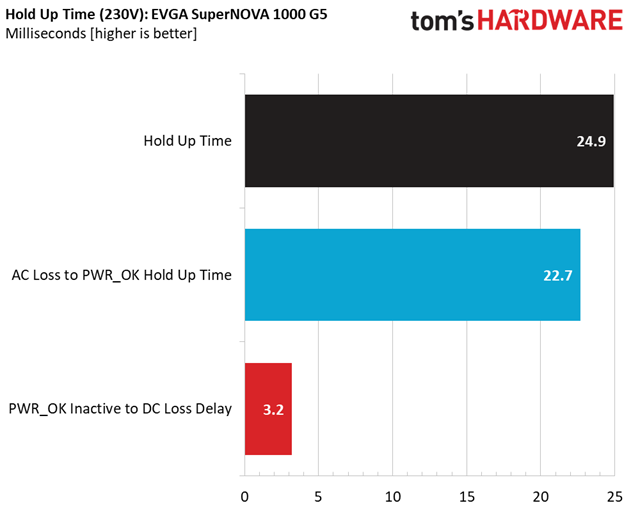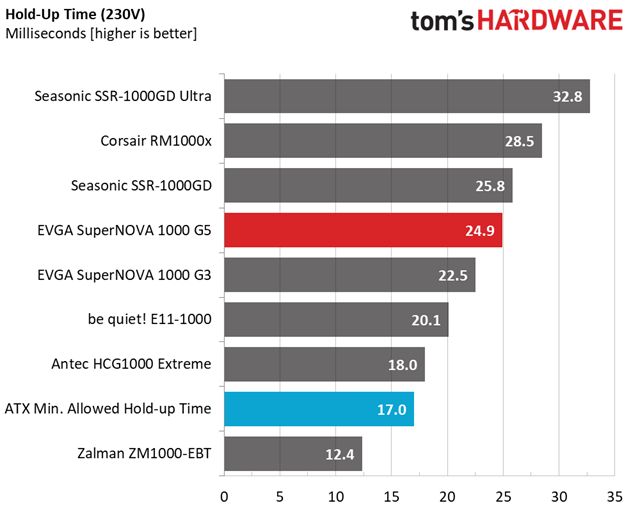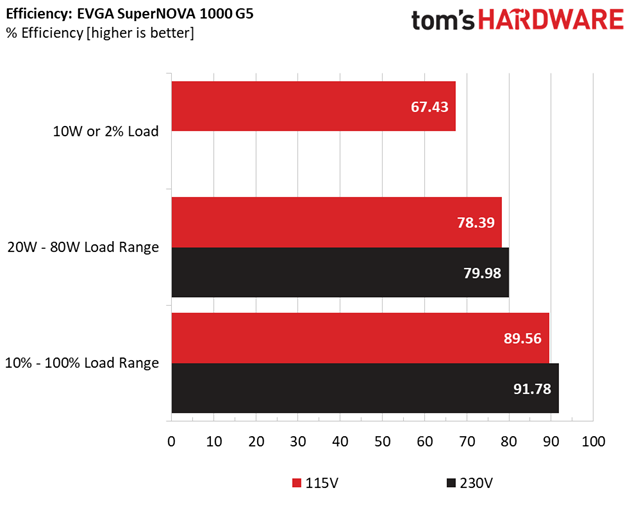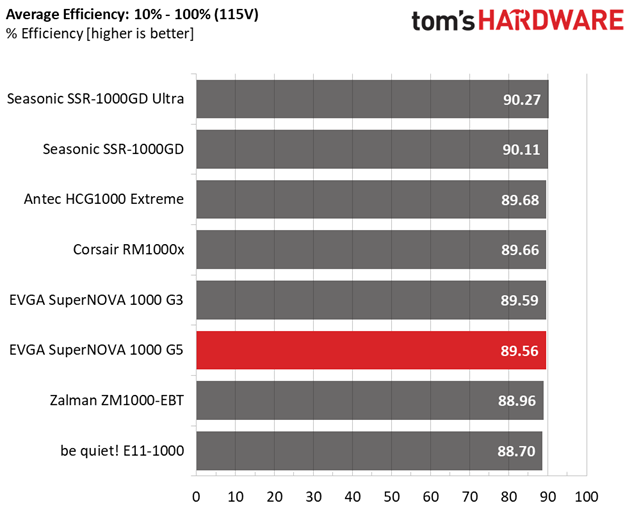EVGA SuperNOVA 1000 G5 Power Supply Review
Why you can trust Tom's Hardware
Load Regulation, Hold-Up Time, Inrush Current, Efficiency and Noise
To learn more about our PSU tests and methodology, please check out How We Test Power Supply Units.
Primary Rails And 5VSB Load Regulation
The following charts show the main rails' voltage values recorded between a range of 40W up to the PSU's maximum specified load, along with the deviation (in percent). Tight regulation is an important consideration every time we review a power supply because it facilitates constant voltage levels despite varying loads. Tight load regulation also, among other factors, improves the system’s stability, especially under overclocked conditions and, at the same time, it applies less stress to the DC-DC converters that many system components utilize.








The load regulation is tight on all rails. Nonetheless, the 1000 G3 achieves higher performance.
Hold-Up Time
Put simply; hold-up time is the amount of time that the system can continue to run without shutting down or rebooting during a power interruption.







The hold-up time is very long. The G5 performs better than the similar capacity G3 in this area.
Inrush Current
Inrush current, or switch-on surge, refers to the maximum, instantaneous input current drawn by an electrical device when it is first turned on. A large enough inrush current can cause circuit breakers and fuses to trip. It can also damage switches, relays, and bridge rectifiers. As a result, the lower the inrush current of a PSU right as it is turned on, the better.


The inrush currents are low, with both voltage inputs.
Get Tom's Hardware's best news and in-depth reviews, straight to your inbox.
10-110% Load Tests
These tests reveal the G5’s load regulation and efficiency levels under high ambient temperatures. They also show how the fan speed profile behaves under increased operating temperatures.
| Test # | 12V | 5V | 3.3V | 5VSB | DC/AC (Watts) | Efficiency | Fan Speed (RPM) | PSU Noise (dB[A]) | Temps (In/Out) | PF/AC Volts |
|---|---|---|---|---|---|---|---|---|---|---|
| 1 | 6.530A | 1.979A | 1.971A | 0.994A | 100.193 | 87.637% | 0 | <6.0 | 44.67°C | 0.964 |
| 12.034V | 5.058V | 3.349V | 5.032V | 114.327 | 40.22°C | 115.17V | ||||
| 2 | 14.048A | 2.970A | 2.958A | 1.194A | 199.899 | 90.634% | 0 | <6.0 | 45.78°C | 0.985 |
| 12.029V | 5.055V | 3.347V | 5.026V | 220.556 | 40.89°C | 115.16V | ||||
| 3 | 21.909A | 3.468A | 3.438A | 1.396A | 299.441 | 91.183% | 1286 | 35.2 | 41.00°C | 0.992 |
| 12.024V | 5.049V | 3.344V | 5.015V | 328.394 | 46.31°C | 115.16V | ||||
| 4 | 29.840A | 3.968A | 3.950A | 1.598A | 399.871 | 91.310% | 1567 | 40.5 | 41.89°C | 0.996 |
| 12.019V | 5.046V | 3.342V | 5.007V | 437.925 | 47.81°C | 115.16V | ||||
| 5 | 37.409A | 4.960A | 4.942A | 1.800A | 499.992 | 90.950% | 1740 | 44.5 | 42.00°C | 0.998 |
| 12.015V | 5.043V | 3.340V | 5.002V | 549.742 | 48.25°C | 115.17V | ||||
| 6 | 44.988A | 5.955A | 5.934A | 2.002A | 600.135 | 90.310% | 2021 | 51.0 | 42.80°C | 0.998 |
| 12.010V | 5.041V | 3.338V | 4.996V | 664.530 | 49.69°C | 115.17V | ||||
| 7 | 52.542A | 6.950A | 6.926A | 2.205A | 699.882 | 89.663% | 2054 | 50.6 | 43.04°C | 0.998 |
| 12.005V | 5.038V | 3.335V | 4.990V | 780.566 | 50.55°C | 115.17V | ||||
| 8 | 60.166A | 7.945A | 7.920A | 2.408A | 800.413 | 88.880% | 2057 | 50.8 | 43.31°C | 0.998 |
| 12.000V | 5.037V | 3.333V | 4.985V | 900.552 | 51.27°C | 115.16V | ||||
| 9 | 68.121A | 8.443A | 8.406A | 2.408A | 899.705 | 88.050% | 2062 | 51.0 | 44.39°C | 0.998 |
| 11.996V | 5.035V | 3.332V | 4.986V | 1021.809 | 52.81°C | 115.17V | ||||
| 10 | 75.925A | 8.944A | 8.920A | 3.023A | 1000.138 | 86.940% | 2065 | 51.1 | 45.52°C | 0.998 |
| 11.991V | 5.033V | 3.330V | 4.963V | 1150.374 | 54.65°C | 115.17V | ||||
| 11 | 84.301A | 8.946A | 8.922A | 3.024A | 1100.154 | 85.902% | 2074 | 51.5 | 46.73°C | 0.998 |
| 11.986V | 5.032V | 3.329V | 4.962V | 1280.709 | 56.44°C | 115.18V | ||||
| CL1 | 0.162A | 14.003A | 14.002A | 0.000A | 119.612 | 81.287% | 0 | <6.0 | 48.39°C | 0.969 |
| 12.030V | 5.064V | 3.339V | 5.124V | 147.147 | 42.15°C | 115.18V | ||||
| CL2 | 83.368A | 1.005A | 1.000A | 1.000A | 1013.169 | 87.245% | 2069 | 51.2 | 45.98°C | 0.998 |
| 11.992V | 5.042V | 3.339V | 5.014V | 1161.290 | 54.96°C | 115.17V |
The 1000 G5 can deliver full load at high ambient temperatures without any problems, besides the loud operation. With more than 51 dB(A) noise output at full speed, even your neighbors will probably complain.
20-80W Load Tests
In the following tests, we measure the G5's efficiency at loads significantly lower than 10% of its maximum capacity (the lowest load the 80 PLUS standard measures). This is important for representing when a PC is idle with power-saving features turned on.
| Test # | 12V | 5V | 3.3V | 5VSB | DC/AC (Watts) | Efficiency | Fan Speed (RPM) | PSU Noise (dB[A]) | PF/AC Volts |
|---|---|---|---|---|---|---|---|---|---|
| 1 | 1.302A | 0.250A | 0.243A | 0.367A | 19.613 | 65.844% | 0 | <6.0 | 0.769 |
| 12.041V | 5.060V | 3.351V | 5.059V | 29.787 | 115.19V | ||||
| 2 | 2.479A | 0.990A | 0.984A | 0.396A | 40.146 | 78.448% | 0 | <6.0 | 0.920 |
| 12.038V | 5.059V | 3.350V | 5.050V | 51.175 | 115.19V | ||||
| 3 | 3.672A | 1.485A | 1.460A | 0.595A | 59.604 | 83.501% | 0 | <6.0 | 0.936 |
| 12.037V | 5.058V | 3.350V | 5.045V | 71.381 | 115.17V | ||||
| 4 | 4.933A | 1.979A | 1.970A | 0.794A | 79.977 | 85.752% | 0 | <6.0 | 0.952 |
| 12.035V | 5.058V | 3.349V | 5.039V | 93.265 | 115.17V |
We would like to see >70% efficiency with 20W load and above 80% with 40W.
2% or 10W Load Test
Intel plans on raising the ante at efficiency levels under ultra-light loads. So from July 2020, the ATX spec will require 70% and higher efficiency with 115V input. The applied load is only 10W for PSUs with 500W and lower capacities, while for stronger units we dial 2% of their max-rated-capacity.
| Test # | 12V | 5V | 3.3V | 5VSB | DC/AC (Watts) | Efficiency | Fan Speed (RPM) | PSU Noise (dB[A]) | PF/AC Volts |
|---|---|---|---|---|---|---|---|---|---|
| 1 | 1.486A | 0.254A | 0.254A | 0.053A | 20.296 | 67.433% | 0 | <6.0 | 0.869 |
| 12.040V | 5.059V | 3.351V | 5.060V | 30.098 | 115.20V |
With 2% load the efficiency is high, but the ATX spec will require for more than 70% from July 2020.
Efficiency
Next, we plotted a chart showing the G5’s efficiency at low loads, and loads from 10 to 110% of its maximum-rated capacity. The higher a PSU’s efficiency, the less energy goes wasted, leading to a reduced carbon footprint and lower electricity bills.





High enough efficiency levels in all load regions (normal, light and super-light).
5VSB Efficiency
| Test # | 5VSB | DC/AC (Watts) | Efficiency | PF/AC Volts |
|---|---|---|---|---|
| 1 | 0.100A | 0.510 | 67.819% | 0.074 |
| 5.099V | 0.752 | 115.16V | ||
| 2 | 0.250A | 1.274 | 76.242% | 0.154 |
| 5.094V | 1.671 | 115.16V | ||
| 3 | 0.550A | 2.797 | 78.216% | 0.276 |
| 5.084V | 3.576 | 115.16V | ||
| 4 | 1.000A | 5.070 | 77.346% | 0.379 |
| 5.069V | 6.555 | 115.16V | ||
| 5 | 1.500A | 7.583 | 78.875% | 0.433 |
| 5.054V | 9.614 | 115.15V | ||
| 6 | 3.000A | 15.020 | 76.837% | 0.498 |
| 5.006V | 19.548 | 115.15V |


The 5VSB rail has low efficiency.
Power Consumption In Idle And Standby
| Mode | 12V | 5V | 3.3V | 5VSB | Watts | PF/AC Volts |
|---|---|---|---|---|---|---|
| Idle | 12.043V | 5.062V | 3.352V | 5.063V | 8.783 | 0.612 |
| 115.2V | ||||||
| Standby | 0.168 | 0.017 | ||||
| 115.2V |


Fan RPM, Delta Temperature, And Output Noise
All results are obtained between an ambient temperature of 37 to 47 degrees Celsius (98.6 to 116.6 degrees Fahrenheit).
The fan profile is aggressive and gets even more aggressive at high operating temperatures.
The following results were obtained at 30 to 32 degrees Celsius (86 to 89.6 degrees Fahrenheit) ambient temperature.
The passive operation goes up to around 210W load. With >760W load the fan gets too loud, exceeding 50 dB(A), so you will probably need earplugs if you plan to stress this PSU.
MORE: Best Power Supplies
MORE: How We Test Power Supplies
MORE: All Power Supply Content
Current page: Load Regulation, Hold-Up Time, Inrush Current, Efficiency and Noise
Prev Page Specifications and Part Analysis Next Page Protection Features, DC Power Sequencing, Cross-Load Tests and Infrared Images
Aris Mpitziopoulos is a contributing editor at Tom's Hardware, covering PSUs.
-
NightHawkRMX I hope pricing can reflec its sub g3 performance.Reply
Its not bad, just not impressive. -
Darkbreeze It is a sad day indeed when EVGA's most go to series falls to this kind of offering. Hopefully, this will be much like the B3 units, and fade quickly away when they realize that their core market for the G2/G3/G5 type units aren't lemmings like those likely to buy the lower end offerings. Couple of bad reviews on the B3 models and that was about the last we heard of them. Maybe this will be the same and EVGA will do what is necessary to get this fixed. In light of the ongoing issues with relationships with Chinese partners, it would be a welcome change to see some of the more influential companies looking into creating facilities elsewhere, although I know that is an unlikely prospect give the considerations of rare earth material and other resource availability.Reply -
jonnyguru Replyrefillable said:Why the higher number tho, the G3 runs circles around this thing.
Apparently, EVGA burned the Super Flower bridge. -
NightHawkRMX Which is kind of a shame in a way.Reply
Some of their superflower derived psus were nice. -
A Very Dangerous Cat Reply
Most of them are, though. Consumers are real stupid.Darkbreeze said:when they realize that their core market for the G2/G3/G5 type units aren't lemmings -
Darkbreeze Obviously you didn't read what I said, when I said "their core market for the G2/G3 type units". Those are not the stupid consumers.Reply
The stupid consumers, are buying the W1, N1, B1, G1, BQ and BT type units. They are not buying higher end GQ, B2, P2 or T2 type units.
The stupid consumers are the ones who can't be bothered to read legitimate, reliable reviews. They can't even be bothered to ask somebody who HAS read them, for advice or guidance. -
Darkbreeze Definitely, some are just ignorant and some are just uninformed. Don't tell me you haven't come across a a good many that were, well, leaning a bit further towards the end of the spectrum.Reply -
Unolocogringo Reply
Thank you !!!!Darkbreeze said:Definitely, some are just ignorant and some are just uninformed. Don't tell me you haven't come across a a good many that were, well, leaning a bit further towards the end of the spectrum.
I needed a laugh






